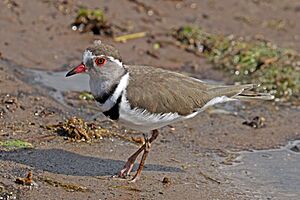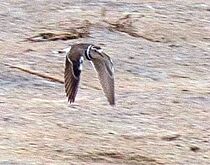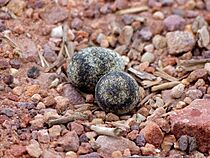Three-banded plover facts for kids
Quick facts for kids Three-banded plover |
|
|---|---|
 |
|
| Chobe National Park, Botswana | |
| Conservation status | |
| Scientific classification |
The three-banded plover (Charadrius tricollaris) is a small bird that lives near water. It is also called the three-banded sandplover. This plover lives all year round in many parts of East Africa, southern Africa, and Madagascar.
You can usually find these birds near rivers, ponds, lakes, and dry lakebeds. They like to be on the open shores of these water places. Often, you will see a single three-banded plover, but sometimes they gather in small groups. They hunt for food by looking for insects, worms, and other small creatures without backbones. The three-banded plover makes a clear, whistling sound that sounds like weeet-weet.
There is a bird called Forbes's plover that is related to the three-banded plover. Forbes's plover is bigger and darker. It lives in West Africa and in wet, tropical areas. The two types of plovers usually live in different places. Both of these plovers look long and thin because they have long tails and wings.
What Does It Look Like?
An adult three-banded plover is about 18 centimeters (7 inches) long. It has long wings and a very long tail. Because of this, it looks different from most other small plovers when it flies. The only exception is its close relative, Forbes's plover.
The top part of an adult three-banded plover is medium brown. Its belly is white, but it has two black bands across its chest. A white band separates these two black bands. This is why the bird is called "three-banded."
Its head has a striking pattern. It has a black top (crown) and white stripes above its eyes (supercilia). These white stripes start at its white forehead and meet at the back of its neck. Its face is grey, turning brown on its neck. The ring around its eye is orange-red. The bottom part of its beak is rosy red, and the rest of the beak is black.
Different Types of Three-Banded Plovers
There is a special type of three-banded plover in Madagascar called C. t. bifrontatus. This type has a grey band between its beak and its white forehead. The sides of its head are also grey. Scientists have found that the plovers in Madagascar are a bit different from those on the mainland of Africa.
Male and female three-banded plovers look very similar in their feathers and size. Young three-banded plovers also look like the adults. However, their forehead is brownish for a short time. Also, the feathers on their wings have buff-colored edges.
You can tell the three-banded plover apart from Forbes's plover. Forbes's plover is bigger and darker. It has a brown forehead and does not have a white stripe on its wing.
Reproduction and Life Cycle
The three-banded plover builds its nest as a simple scrape on small stones or gravel. In tropical areas, they lay eggs from March to June. In southern Africa, they mostly lay eggs from July to October. This is during the late winter and early spring there.





